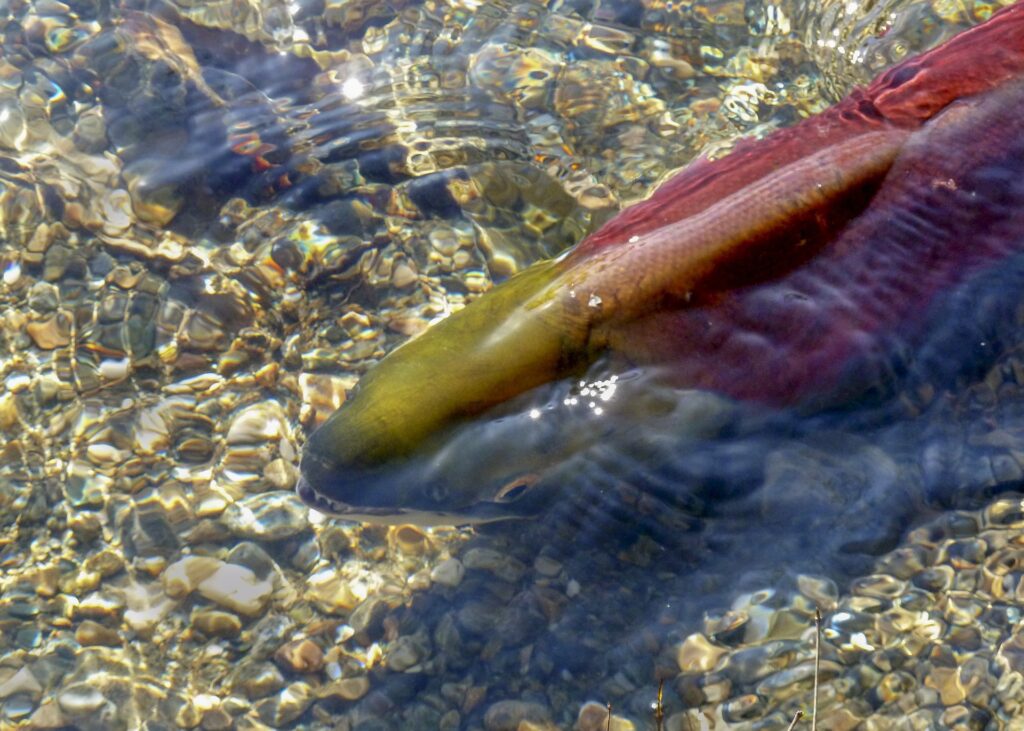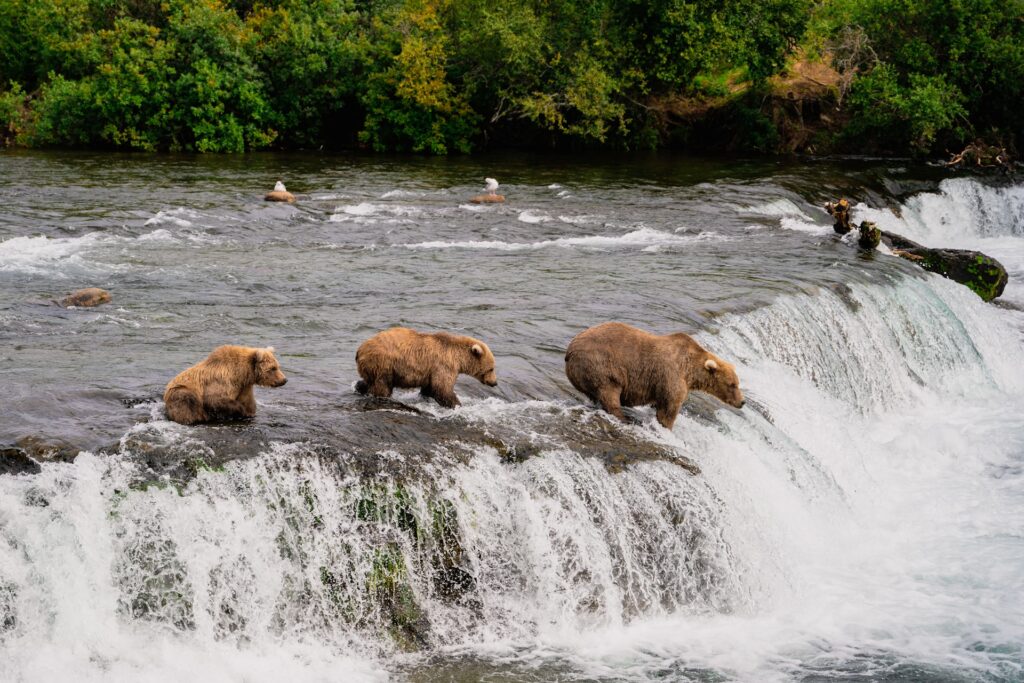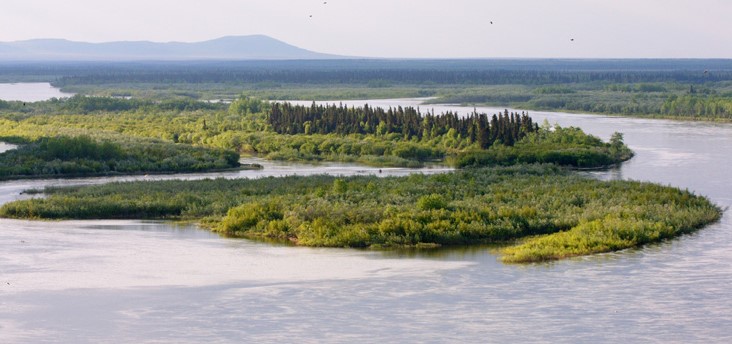Salmon are a resilient, transformative fish that feature in mythologies of Native American cultures as well as European – and they taste good, too! In fact, with a high concentration of omega 3 fatty acids as well as vitamin D, salmon is considered a health food.
Life Underwater

Salmon live their lives on the move. In fact, thriving in both the Atlantic and Pacific Oceans, varieties are found throughout the Northern Hemisphere. These fish are actually anadromous, meaning their lives are spent both in fresh and salt water. Born in freshwater streams, they make their way to the sea, where they spend most of their lives, before returning to freshwater to spawn. While they can live several years, few live long past spawning. Silvery-blue throughout their seafaring days, they are actually pale and spotted as juveniles, and their return to fresh water prompts several changes, including exchanging blue for a brilliant red color.
One of the most iconic features about this fish, however, is the incredible return journey they make to their natal streams when it is time to spawn. Some travel hundreds, occasionally thousands, of miles upstream, fighting waterfalls and currents along the way. This fierce determination and transformative behavior have impacted numerous mythologies, including Irish, Norse, and Haida. The sight of them jumping up the rapids has even inspired their name – the word salmon comes from a Latin word meaning “to leap.”
Want to Know More?
Check out this World Wildlife Fund article!

Life On Land
As salmon make their way up streams and rivers in the autumn, more than the chance to spawn is waiting. In fact, humans aren’t the only ones who think salmon is delicious! Did you know that a hungry grizzly bear can eat up to 30 salmon a day? And not just bears. Wolves, eagles, and even water birds all feast on salmon when they come flooding though the mountain streams.
This is a place of water, home to half the world’s wild sockeye salmon. Every summer, tens of millions of salmon return to these waters, creating a huge pulse of life.
Keystones
Salmon are what is known as a keystone species. Keystone is an architectural term for the wedge-shaped stone at the top of an arch – the one that locks all the others into place and keeps the structure together. A keystone species is one which produces a major impact on its ecosystem.[1] In fact, it is essential to maintaining the ecosystem’s continuity and equilibrium.
Want to Know More?
Check out this National Geographic article!

As a keystone species, salmon are a major food source, and not just on land. For example, Chinook salmon are the main food source for the endangered Southern Resident killer whales.[2] The very act of swimming upstream is vital to the forest ecosystems where they spawn, as they bring nutrients from the ocean to predators such as wolves and eagles, as well as the rich organic matter left over from their dead carcasses. It might sound ghastly, but these nutrients enhance the productivity of the entire forest ecosystem, even dozens of species of insects – of which they were the main predator as juveniles en route to the sea.
Want to Know More?
Check out this Pacific Wild article!
Besides being a healthy dining option, salmon is a popular feature in many traditional cuisines from Scottish Tweed Kettle (or salmon hash) to Swedish Lax[3] to Japanese grilled miso salmon[4] to Alaskan salmon bakes. In Alaska, these fish are also a staple of life. Salmon aquaculture is actually the fastest growing food production system in the world right now. But not all salmon is farmed, some remains wild caught. In fact, the largest sockeye salmon fishery in the world is in Bristol Bay, southwestern Alaska.[5] But Bristol Bay is in danger.
A Vital Cycle
The largest open-pit mine in North America, the Pebble mine, was proposed to extract vast amounts of copper and gold. Early in 2023, however, the U.S. Environmental Protection Agency opposed the project. While the mine would undoubtedly have unearthed billions of dollars in mineral wealth, it also would have unacceptably harmed the world’s largest commercial sockeye fishery (valued at 2.2 billion annually) as well as some two dozen Alaska Native villages eking out a living in the region.[6] And besides the thousands of families’ livelihoods and the indigenous cultures continuing that have thrived there for 10,000 years, the loss of salmon upriver would disrupt the entire natural ecosystem. As seen in the return of gray wolves to Yellowstone, the presence of apex predators sustains life at all levels. Without the proper balance, prey animals thrive too well and overtake their neighbors’ homes, leaving some species to starve and others to seek a better life elsewhere. Thousands of acres of wetlands, lakes, and ponds as well as 81 miles of salmon streams, plus more thousands of acres in the watershed would be fragmented, dewatered, and covered with dust from the mine.[7] As a dumping ground for the gigantic mine’s waste, more than just the salmon and the killer whales who eat them would vanish.
Want to Know More?
Check out this Yellowstone National Park Trips article!
While the vast sums of money that could be generated by Pebble mine is certainly attractive, the cost to human lives and livelihoods, the disruption of ecosystems from the mountains through the seas, the poisoning of the watershed with mine tailings, all adds into an incomprehensible loss of life. As we move forward supporting initiatives to improve life on Earth, legislation such as the Clean Water Act that has thus far halted Pebble mine offer a glimmer of hope that we as humans can stand firm in our defense of the world we share with the insects, salmon, and bears. Without any one of them, none of us would be the same.

[1] https://www.merriam-webster.com/dictionary/keystone
[2] https://www.fisheries.noaa.gov/west-coast/sustainable-fisheries/ecosystem-interactions-and-pacific-salmon
[3] https://www.tasteatlas.com/salmon-dishes
[4] https://www.youtube.com/watch?v=XUFhXctTvIw&t=9s
[5] https://www.epa.gov/bristolbay/about-bristol-bay
[6] https://www.adn.com/business-economy/2023/02/01/whats-next-for-pebble-now-that-the-federal-government-has-taken-extraordinary-action-to-stop-it/
[7] https://earthjustice.org/feature/alaska-bristol-bay-pebble-mine
